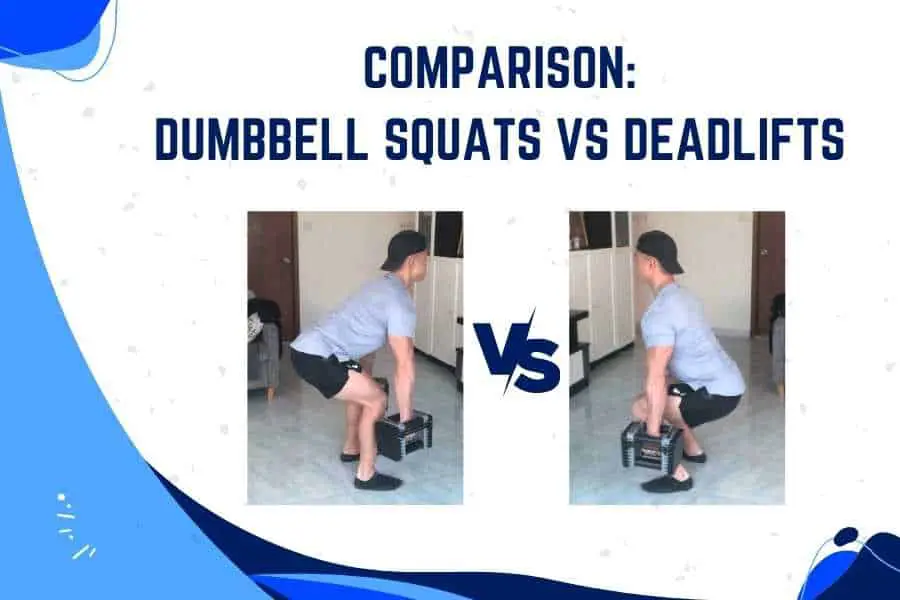Squats and deadlifts are two of the best dumbbell exercises to strengthen the lower body. But they can look like very similar exercises to the untrained eye. So what are the differences between the dumbbell squat vs deadlift, and which one is better?
Dumbbell squats are a quad-dominant movement that emphasizes the quadriceps and hip flexors. In contrast, dumbbell deadlifts are a hip-dominant exercise that emphasizes the hamstrings, glutes, and lower back. Both movements are effective and target the lower body differently.
Below, I’ll share a full explanation of form, function, and target muscle differences. I’ll also explain why one is not inherently better than the other, and how to include both exercises in your program!
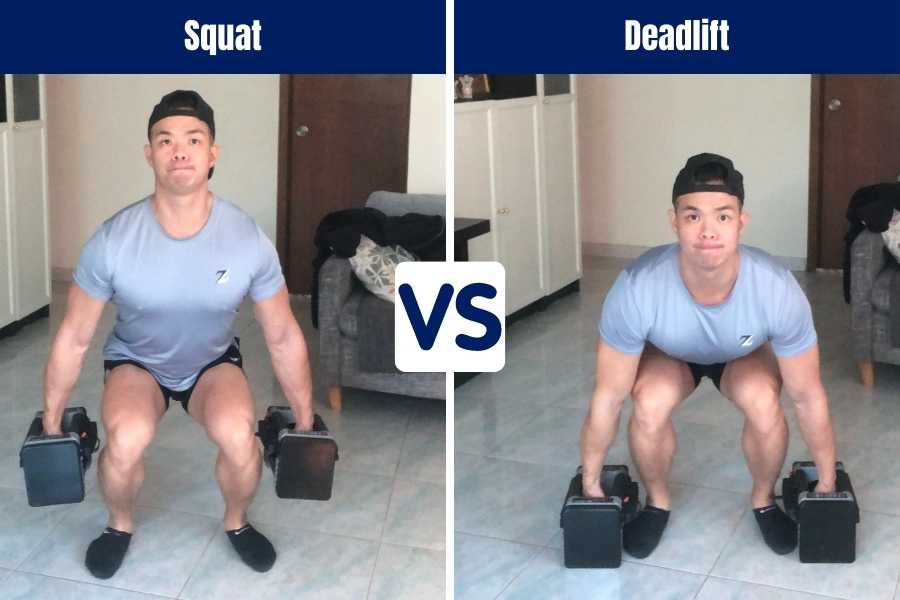
- Key Takeaways:
- Similarities & Differences Between The Dumbbell Squat Vs Deadlift
- Target Muscles In Dumbbell Squats Vs Deadlifts
- Form Differences Between The Dumbbell Squat Vs Deadlift
- Functional Differences Between The Dumbbell Squat Vs Deadlift
- Which Exercise Is Better?
- Which Exercise Allows More Weight To Be Lifted?
- 3 Ways To Combine Dumbbell Squats And Deadlifts
- FAQ
- Conclusion
Key Takeaways:
- Both exercises utilize different form and technique cues, and emphasize different muscles.
- Squats are a quad-dominant pushing exercise. Use them to emphasize the front leg muscles (anterior chain) like the quadriceps and hip flexors.
- Deadlifts are a hip-dominant pulling exercise. Use them to emphasize the rear leg muscles (posterior chain) like the hamstrings, gluteus maximus, and lower back.
- To build bigger and stronger legs- include both exercises and lift heavy.
- To improve general fitness- include one or both exercises.
Similarities & Differences Between The Dumbbell Squat Vs Deadlift
If there are two exercises that skinny beginners should do to build bigger and stronger legs, it’s squatting and deadlifting.
Although the two exercises share many similarities in terms of execution and target muscles, they also have differences that confer unique benefits.
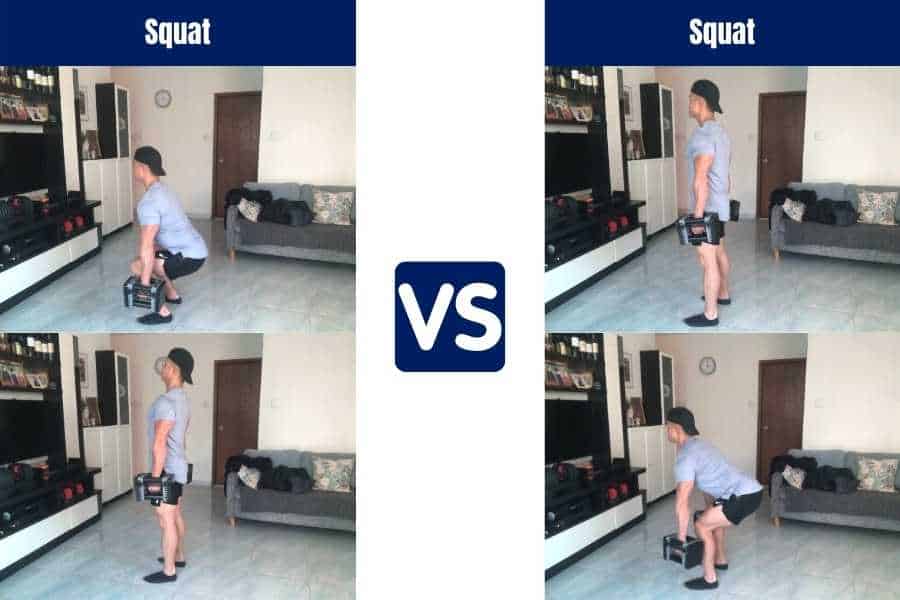
Here are the main similarities between the dumbbell squat vs deadlift:
- Compound movements. Both exercises are full-body movements that engage multiple muscles in a single movement.
- Focus on the lower body. Both exercises mainly target the leg muscles but also engage the core and lower back for stabilization.
- Vertical path of motion. Both exercises move in the vertical plane. In other words, you move up and down.
- Popular and effective. They are two of the most basic and popular exercises for beginner and advanced workout programs alike. Multiple variations exist for both exercises to shift emphasis onto select muscles.
Here are the main differences between the dumbbell squat vs deadlift:
| Dumbbell Squat | Dumbbell Deadlift |
|---|---|
| Dumbbell is pushed away from the floor using the legs. | Dumbbell is pulled off the floor using the legs and arms. |
| Quad-dominant movement. | Hip-dominant movement. |
| Emphasis on the anterior chain muscles (quadriceps and hip flexors). | Emphasis on the posterior chain muscles (hamstrings, glutes, and lower back). |
| Hip crease can drop deeper at the bottom of the movement for greater anterior chain activation. | Hip crease usually sits higher for greater posterior chain activation. |
| Torso is kept at a more vertical and upright angle throughout the movement. | Torso leans forward at the bottom of the movement and transitions vertically at the top. |
| Dumbbell never touches the floor. | Dumbbell is lifted from floor to air. |
Thus, the dumbbell squat and deadlift both work the lower body.
But due to the biomechanical differences, the two exercises work the individual leg muscles to different degrees.
Next, I’ll explain these difference in more detail.
Target Muscles In Dumbbell Squats Vs Deadlifts
The squat and deadlift are both big compound lower-body exercises.
They primarily engage the lower body muscles. But the back and abdominal muscles are also recruited to stabilize the movement.

Here are the main muscles worked in the dumbbell squat and deadlift:
- Quadriceps and hip flexors. Straightens your legs during the upward phase (also called knee extension) and brings your hips backward during the downward phase (also called hip flexion)
- Hamstrings. Bends the legs together during the downward phase (also called knee flexion) and brings the hips forward during the upward phase (also called hip extension).
- Gluteus maximus. Drives hip extension during the upward phase and stabilizes hip flexion during the downward phase.
- Calves. Stabilize knee flexion and extension by keeping your feet planted firmly onto the ground.
- Back muscles. Stabilize the squat and deadlift by keeping in ga straight lower, mid, and upper back.
As you can see, both exercises engage a similar array of muscles.
But due to the biomechanics of the bottom phase, the muscles are activated to different degrees between the squat vs deadlift (see next).
Form Differences Between The Dumbbell Squat Vs Deadlift
Understanding how each exercise is executed will help you to understand why the dumbbell squat and deadlift work the leg muscles differently.
How to execute the dumbbell squat (also called a suitcase squat) with perfect form:
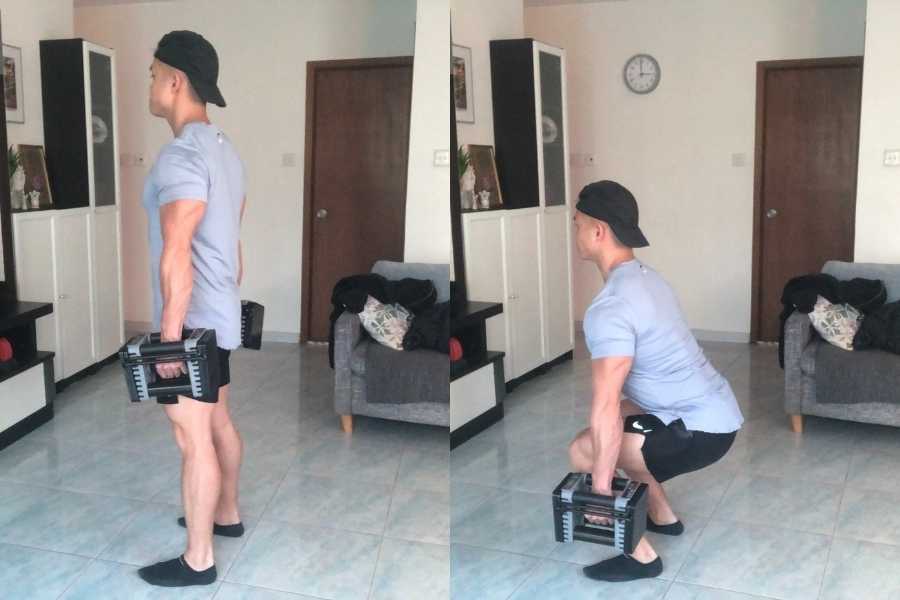
- Stand with a natural shoulder-width stance and hold the dumbbells on either side of your legs.
- Slowly bend your knees and drop your hips backward to lower the dumbbells.
- Stop when the upper thighs are parallel to the ground and the hip is level with the knee.
- Drive upwards back into the starting position.
- Maintain a straight back throughout the motion (the back should not go below 45° relative to the hips).
Different variations of the dumbbell squat also exist and work the legs differently.
For example, the goblet squat positions a dumbbell directly above the thighs and forces you to keep a vertical back. As a result, this further emphasizes quad activation.
How to execute the dumbbell deadlift with perfect form:
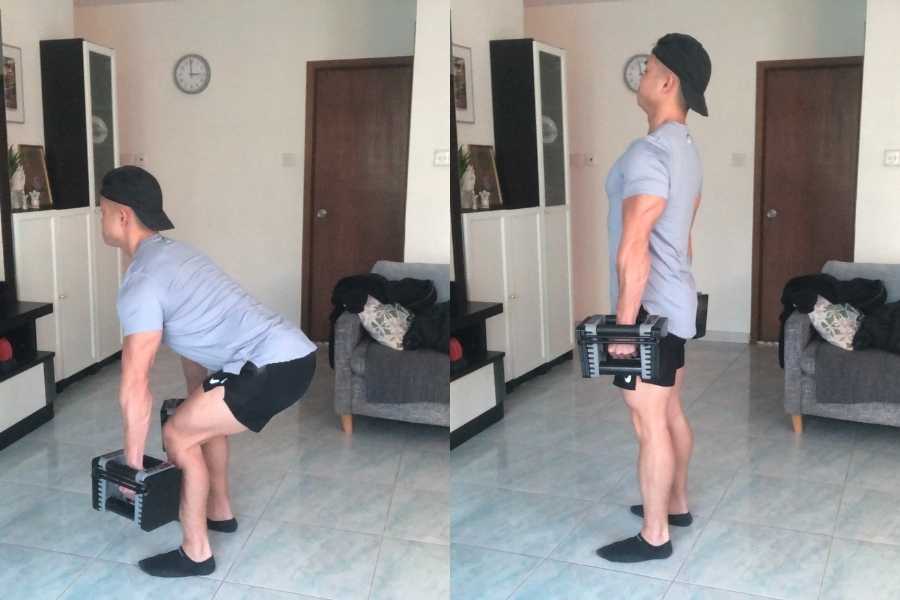
- Assume a natural shoulder-width stand and place both dumbbells on the floor next to your feet (parallel to each other). You can also place the dumbbells slightly in front if you prefer (like in the photo above).
- Bend your knees and drop your hips back and down to lower the torso and grip each dumbbell.
- This is your starting deadlift position- the hips should be above the knees and the chest should be above the hips. Keep your head up and maintain a straight back.
- Pull the dumbbells off the floor by extending your knees and thrusting your hips forwards.
- Push your chest and hips out at the top of the deadlift. (aka a proud chest).
- Hold this position for a second and lower the dumbbells back onto the floor by bending the knees and bringing your hips down and back.
The dumbbell deadlift can also be performed with the dumbbells held in front of you rather than to the side. People with wider hips may find this variation to be more comfortable.
Functional Differences Between The Dumbbell Squat Vs Deadlift
The main form differences between the dumbbell squat and deadlift reside in the bottom position and the way you lift the weight through the air.
These differences confer each exercise with unique functional benefits and varying degrees of leg muscle activation.
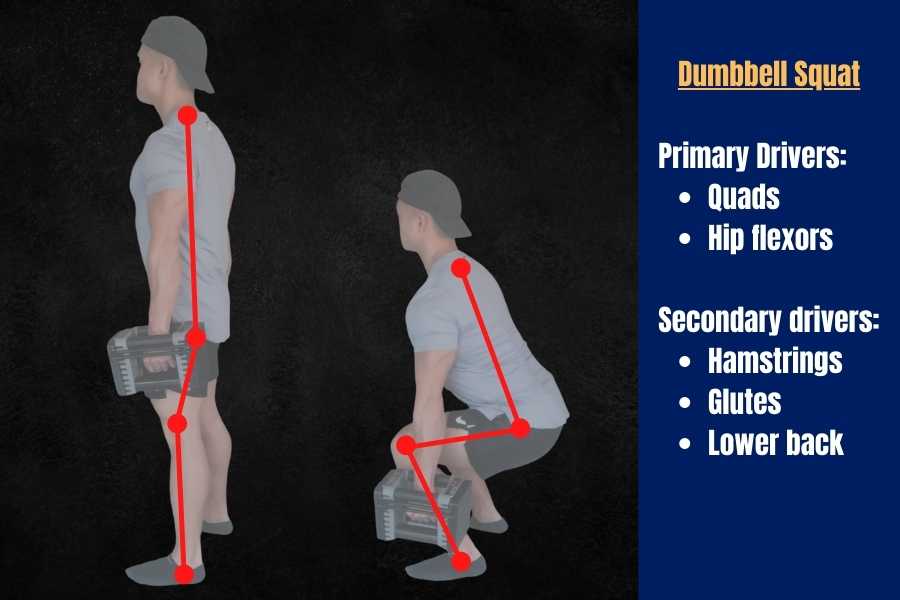
The dumbbell squat is classified as a quad-dominant exercise (especially in front-loaded variations like the goblet squat).
In quad-dominant movements, flexion/extension mainly occurs around the knee joint and less in the hips. Furthermore, your torso is maintained in a more vertical orientation.
Additionally, the focus of the dumbbell squat is to lower the weight to the floor before driving upwards using your knees.
As result, your anterior-chain muscles (quads and hip flexors) serve as the primary drivers whilst the posterior-chain muscles (hamstrings, glutes, and lower back) serve to stabilize the exercise.
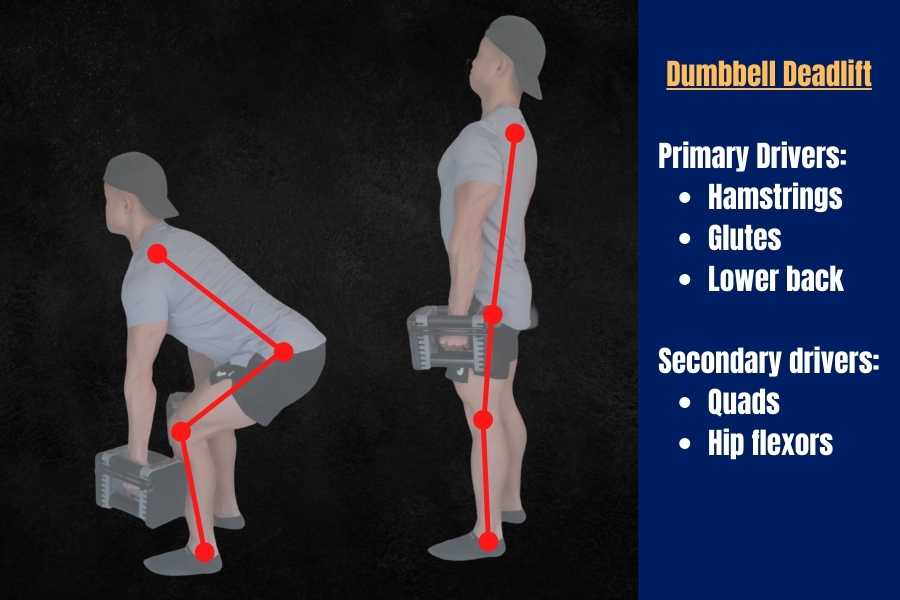
In contrast, the dumbbell deadlift is considered to be a hip-dominant exercise.
In hip-dominant movements, flexion/extension mainly occurs around the hip joint and less in the knees. Furthermore, your torso is held less vertically and has more horizontal orientation at the bottom of the exercise.
Additionally, the focus of the dumbbell deadlift is to combine upper-body pulling with lower-body drive to lift the weight off the floor.
As result, your posterior-chain muscles (hamstrings, glutes, and the spinal erectors of the lower back) serve as the primary drivers whilst the anterior-chain muscles (quads and hip flexors) serve to stabilize the exercise.
Which Exercise Is Better?
Neither squats nor deadlifts are inherently better than the other. Both exercises can develop lower body strength and muscle when performed correctly. Squats are ideal for emphasizing the quadriceps, whilst deadlifts are great for emphasizing the hamstrings and lower back.
In support of this, a 2015 study found that squatting and deadlifting both resulted in similar gains in sprinting and jumping performance.
Common benefits shared by squatting and deadlifting:
- Bilateral movements. Bilateral movements require both sides of your body to work in a coordinated manner. Additionally, bilateral movements are replicated in everyday activities such as lifting and moving objects.
- Great for lower body strength development. Both exercises can be loaded with heavy weights to develop maximum power and strength.
- Induces lower body hypertrophy. Both exercises engage all muscles in the lower body and when performed with weights that challenge you for 8-12 reps, are great for leg size development.
- Suitable for general fitness. Both exercises engage lots of muscles in one movement, and this makes them great for dumbbell cardio and HIIT workouts when performed with high reps and moderate weights.
Unique benefits of the squat vs deadlift:
- Squats are ideal for building the legs. Squatting is generally more fatiguing for your legs since they are required to move through a greater range of movement. Squats are great if you want to develop the quads and build overall leg muscle.
- Deadlifts are ideal for building full-body muscle and the posterior chain. Deadlifting is generally less fatiguing for your legs because they move through a smaller range of movement. But an overall greater workload is presented to your whole body, including the posterior chain muscles.
Which you should pick:
Therefore, your training goal (which muscles you want to train more) should influence your choice between squats vs deadlifts.
But ideally, you should include both for the best results.
It should be noted, however, that this 2015 study suggests beginners may find the dumbbell squat easier to perform since it’s a less complex movement.
So as a beginner, it may be easier to master the dumbbell squat before you start deadlifting.
Which Exercise Allows More Weight To Be Lifted?
If your primary training goal is to build muscle and strength, then it’s essential to lift heavy weights.
So which exercise allows for more weight to be lifted between the dumbbell squat vs deadlift?
Most people are able to deadlift around 10% more weight than they can squat. The deadlift is an overall larger movement that recruits more muscles compared to the squat.
Thus, if you’re looking to build full-body muscle, then it may be best to include some form of deadlifting in your program.
For exact weight standards, you can follow the links below:
3 Ways To Combine Dumbbell Squats And Deadlifts
1) Alternate Between squatting and deadlifting.
The best way to combine dumbbell squats and deadlifts into your program is to alternate between the exercises on different training days.
In a 3-day workout split example- you could squat on Monday, deadlift on Wednesday, and squat again on Friday.
For a full routine, you can check out my muscle-building dumbbell home workout
2) Squat and deadlift on the same workout.
Alternatively, you can do squats and deadlifts on each workout if you decrease the total number of sets for each exercise.
For example- instead of doing 5 sets of squats on Monday, you could do 3 sets of squats plus 2 sets of deadlifts.
The most important consideration is to equate your total training volume. The legs should not be worked by more than a total of 15 heavy sets in the week. This can help you avoid overtraining.
Additionally, it’s generally not a good idea to train legs every day with intense sessions.
3) Hybridize with squat to deadlifts
You can also combine the dumbbell deadlift and squat into a single movement to save time.
This is a great way for beginners to gain the benefits of both.
It’s good exercise for building general fitness.
However, for people looking to maximize muscle growth, it’s better to perform dedicated sets for each exercise.
FAQ
Is squatting with dumbbells effective?
Dumbbell squats are effective for beginners. This exercise primarily works the quadriceps, hamstrings, glutes, and calf muscles in the legs. Trained lifters who are looking to maximize muscle and strength gains will find barbell squats to be better due to the heavier weights available.
How much should I deadlift with dumbbells?
Beginners can start deadlifting with 10-20lb dumbbells. Lighter dumbbells are ideal for people to safely practice the deadlift. Once comfortable with the movement, aim to lift a dumbbell weight that is challenging for 6-12 reps.
Are deadlifts better with dumbbells?
Deadlifts are usually performed with barbells. This allows heavier weights to be loaded which is ideal for building muscle and strength. However, beginners may find dumbbells to be safer, less intimidating, and more convenient to use compared to a barbell.
Are deadlifts as effective as squats?
Deadlifts are more effective than squats for working the full body. In contrast, squats are better for emphasizing the legs. They should be treated as separate and incomparable exercises since they work different muscle groups to varying degrees.
Conclusion
There are many similarities between the dumbbell squat vs deadlift.
They’re both lower-body compound movements that work the legs as well as the back and core for stabilization.
The main differences reside in their execution and primary target muscles.
Squats are a quad-dominant movement that emphasizes the anterior-chain muscles (quads and hip flexors). Deadlifts are hip-dominant movements that emphasize the posterior-chain muscles (hamstrings, glutes, and lower back).
Ideally, you should include both of them in your program to gain full benefits!
You may also be interested in the downloadable Kalibre Blueprint PDF which details exactly how I gained 40lbs of lean muscle (it’s 100% free!). It details the exact exercises and nutrition (with printables) I used to go from skinny to ripped!

